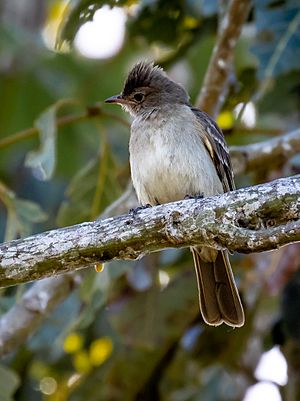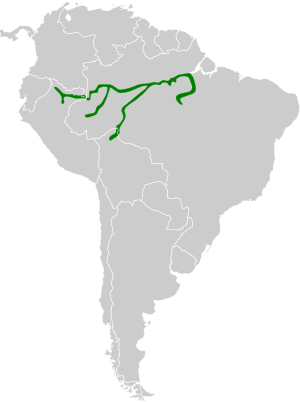Brownish elaenia facts for kids
Quick facts for kids Brownish elaenia |
|
|---|---|
 |
|
| Brownish elaenia at Iranduba, Amazonas, Brazil | |
| Conservation status | |
| Scientific classification | |
| Genus: |
Elaenia
|
| Species: |
pelzelni
|
 |
|
The brownish elaenia (scientific name: Elaenia pelzelni) is a type of bird. It belongs to a bird family called Tyrannidae, which are also known as tyrant flycatchers. These birds are found mostly along the big rivers of the Amazon Basin. You can spot them in Brazil, northern Peru, near the border of Colombia, and in Bolivia. Their favorite home is in warm, wet lowland forests in tropical and subtropical areas.
Contents
Where Does the Brownish Elaenia Live?
The brownish elaenia lives in the central part of the Amazon Basin. They are often found along the Amazon River itself. They also live near many other large rivers that flow into the Amazon. These birds like to stay in wide "river corridors," which are like long, narrow strips of land along the rivers. These corridors can be about 125 kilometers (about 78 miles) wide.
Rivers in Brazil
In Brazil, you can find the brownish elaenia along several important rivers:
- The Xingu River: Their home starts where the Xingu River meets the Amazon. They live along the Xingu for about 700 kilometers (435 miles) upstream.
- The Rio Iriri: This river is a branch of the Xingu. The birds continue to live along the Rio Iriri for another 700 kilometers (435 miles).
- The Madeira River: This river is in the southwest part of the Amazon Basin. The brownish elaenia's range goes a long way up the Madeira River, about 2,400 kilometers (1,490 miles). This takes them all the way to the river's starting points in northern Bolivia.
- The Juruá River: This river flows from the southwest into the Amazon. The birds live along the Juruá River for about 950 kilometers (590 miles).
Rivers in Peru and Colombia
Moving west, the brownish elaenia's home continues as the Amazon River changes its name to the Marañón River in Peru. They live along the Marañón River all the way to its starting points in northern Peru. You can also find them along the border between Brazil and Colombia, for about 200 kilometers (124 miles).
See also
 In Spanish: Fiofío pardo para niños
In Spanish: Fiofío pardo para niños


